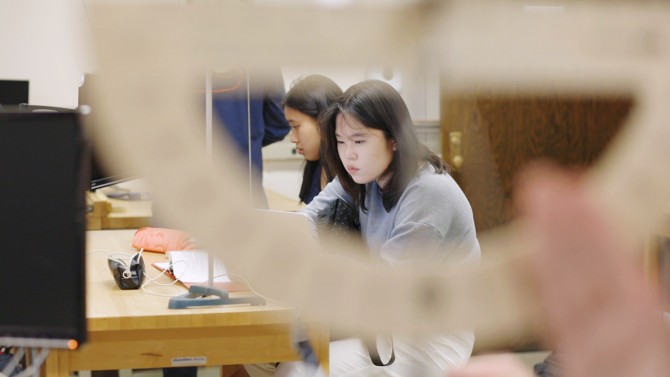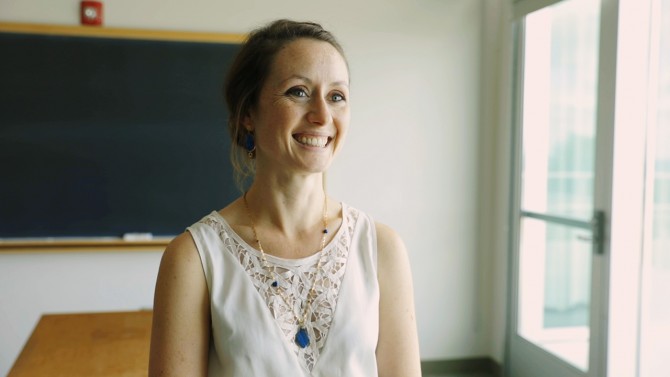Natasha Holmes, the Ann S. Bowers Assistant Professor in the College of Arts and Sciences, speaks about how her research shows that traditional physics labs, which strive to reinforce the concepts students learn in lecture courses, can actually have a negative impact on student learning, while nontraditional, inquiry-based labs that encourage experimentation can improve student performance and engagement without lowering exam scores.
Inquiry-based labs give physics students experimental edge
By David Nutt
New Cornell research shows that traditional physics labs, which strive to reinforce the concepts students learn in lecture courses, can actually have a negative impact on students. At the same time, nontraditional, inquiry-based labs that encourage experimentation can improve student performance and engagement without lowering exam scores.
The findings were published in a paper, “Direct Measurement of the Impact of Teaching Experimentation in Physics Labs,” published Feb. 10 in Physical Review X.
The research grew out of the Active Learning Initiative, launched in 2013 in the College of Arts and Sciences. The effort now fosters creative classroom strategies and education research across campus.
“Typical physics lab courses are designed to help students see or observe the physics phenomena that we typically teach in a lecture course,” said senior author Natasha Holmes, the Ann S. Bowers Assistant Professor in the College of Arts and Sciences. “In our previous work, we had this idea that these labs weren’t effective. But we were pretty sure that we could restructure the labs to get students engaging and really learning what it means to do experimental physics.”
The researchers created a controlled study in which students were divided into five lab sections for the same introductory, calculus-based physics course, focusing on mechanics and special relativity. Students in all five lab sections went to the same lectures and had identical problem sets, homework and exams. However, three lab sections followed the traditional model; the remaining two sessions were inquiry-based labs, with students making their own decisions about gathering and analyzing data.
For example, one of the first experiments required students to compare the period of a pendulum – the duration for a complete back-and-forth swing – at two angles of amplitude. In the traditional lab model, the students followed instructions on a worksheet. In the inquiry-based lab, the students decided what data they needed to collect, where and how to collect it, and how to analyze the data. This resulted in students setting up their own equipment and standing on chairs and desks, affixing the pendulums to cables attached to the ceiling, and trying other imaginative methods to adjust the pendulum string and get more accurate measurements.
“The students in the new labs are much more active,” Holmes said. “They are talking to each other, making decisions, negotiating. Compared to the traditional lab, where everyone’s really doing the same thing and just following instructions, we now have all of the students doing something completely different. They’re starting to be creative.”
The researchers repeated the semester-long study twice more. They found that students in the inquiry-based labs showed more positive attitudes and perceptions toward experimental physics. These students also displayed more spontaneous, critical thinking when evaluating their data, and they were more willing to reject textbook theories when their own findings contradicted them.
The exam scores were the same for students in the traditional and inquiry-based labs. However, the traditional lab model negatively impacted student attitudes toward experimentation and failed to engage students with high-level scientific thinking, the researchers found. Students who had low pre-scores fared worse when enrolled in the traditional lab.
Another telling distinction: Students in traditional labs completed their tasks as quickly as possible, often breezing through the instructions and finishing the two-hour session in 30 minutes, then leaving. Students in the inquiry-based labs tended to work for the full two hours.
“We think it’s teaching them to have ownership over their experiments, and they’re continuing to investigate,” Holmes said. “We actually had trouble kicking them out of class – which I think is a pretty good problem to have.”
Holmes believes the inquiry-based lab model is applicable to other disciplines, although physics has distinct advantages over chemistry or biology, where trial-and-error experimentation could result in wasted chemicals, materials and time.
“In some sense, the results are not very surprising,” said lead author Emily Smith, a former postdoctoral researcher who is currently a teaching assistant professor at the Colorado School of Mines. “Researchers and instructors have been dissatisfied with traditional physics labs for decades. Yet, change has been very slow, and one reason is that instructors are concerned that removing the verification aspect of the labs will negatively impact students’ learning. This study shows directly that the change can happen with no impact to students’understanding of conceptual physics ideas, and with positive benefits to their behavior and attitudes toward experimental physics.”
Ph.D. students Martin Stein and Cole Walsh contributed to the paper.
The research was supported in part by the Active Learning Initiative and the President’s Council for Cornell Women Affinito-Stewart grant program.
Media Contact
Get Cornell news delivered right to your inbox.
Subscribe


